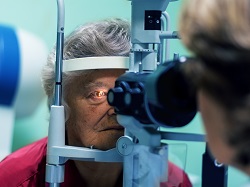Hispanics and Latinos Have Higher Risk for Vision Loss

Some conditions that are common among Hispanics and Latinos put them at risk for vision loss. If you are Hispanic or Latino, know your risk and take steps to protect your eye health.
Some chronic conditions, such as diabetes and high blood pressure, can put you at higher risk for vision loss, and these conditions are more common among Hispanics and Latinos than non-Hispanic whites.
- Hispanics and Latinos are almost 2.5 times more likely to have diabetes, compared to non-Hispanic whites.
- 68% of Hispanics and Latinos have poorly controlled high blood pressure, compared to 54% of non-Hispanic whites.
Diabetes can lead to diabetic retinopathy, the leading cause of blindness in working-age adults in the United States. High blood pressure can cause glaucoma. Because Hispanics and Latinos are the largest and fastest-growing minority group in the United States, by 2050, half of people living with glaucoma will be Hispanic or Latino. Other eye conditions that lead to vision loss, if not treated, are cataracts and uncorrected refractive error.
Conditions Affecting the Health of Hispanics and Latinos
In addition to having higher rates of diabetes and high blood pressure, Hispanics and Latinos are less likely to:
- Have had an eye exam—which makes them less likely to get diagnosed and treated for eye conditions that lead to vision loss.
- Participate in daily physical activity—which increases your risk of being overweight or having obesity and can lead to diabetes and other chronic conditions.
- Be able to access health and eye care services—because of language barriers and/or health insurance coverage.
Social factors also play an important role in the health of Hispanics and Latinos. Social factors contributing to poorer health in this population are:
- Living in poverty, increases the chance of not being able to afford medical services and devices such as eye exams and eyeglasses.
- Lower levels of educational attainment. In fact, 1 in 3 Hispanics/Latinos do not complete high school.
- Feelings of discrimination from physicians if Hispanic/Latino patients do not speak English.

Know how to keep your eyes healthy.
What Can You Do?
There is encouraging news: serious eye conditions such as diabetic retinopathy and glaucoma can be detected and treated early, before vision loss occurs. Make eye health a priority for yourself and your family. Follow these simple tips for healthy vision:
- Use protective eyewear. Protective eyewear should be used during high-risk activities such as working on the job, doing yardwork, or playing sports.
- Learn about your family’s history of eye disease. Some eye diseases can be hereditary, such as glaucoma, so it is important to share your family history with your eye doctor.
- Quit smoking or never start. It increases your risk of developing age-related macular degeneration and cataracts, and increases the severity of diabetic eye disease.
- Live a healthy lifestyle. Eating a healthy diet can help you maintain a healthy weight, which lowers the risk for type 2 diabetes.
- Manage your chronic conditions. If you have a chronic condition, such as diabetes or high blood pressure, it is important to take your medicines as prescribed to help manage your condition.